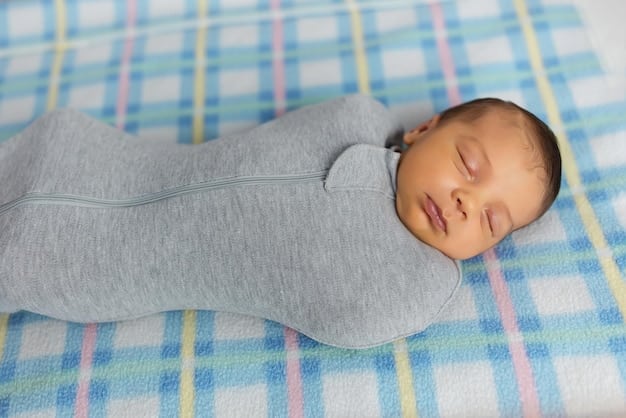Weighted Sleep Sack vs. Swaddle: Which is Best for My Baby?

Comparison/Analysis: Weighted sleep sacks and swaddles are designed to help babies sleep better by providing comfort and security, but they cater to different stages and needs; swaddles are best for newborns with startle reflexes, while weighted sleep sacks are suitable for older babies who can roll over.
Choosing the right sleepwear for your baby can feel overwhelming. Both weighted sleep sacks and swaddles are popular options, but understanding their differences is key. This Comparison/Analysis: Weighted Sleep Sacks vs. Swaddles: Which is Best for Your Baby? guide will help you make the best choice for your little one’s sleep and safety.
Understanding the Basics: Swaddles and Sleep Sacks
Swaddles and sleep sacks are designed to help babies sleep soundly and safely. Each has its benefits, but understanding their primary function is the first step in making the right choice for your baby.
What is a Swaddle?
A swaddle is a blanket wrapped snugly around a baby’s body, mimicking the feeling of being held in the womb. This helps to suppress the Moro reflex (startle reflex), which can disrupt a newborn’s sleep.
What is a Sleep Sack?
A sleep sack, or wearable blanket, is a sleeveless garment that a baby wears like a sleeping bag. It provides warmth and comfort without the risk of loose blankets in the crib. Some sleep sacks come with added weight, which proponents believe can have a calming effect.
Here’s a quick breakdown of the primary differences:
- Swaddles: Best for newborns, restricts arm movement, reduces startle reflex.
- Sleep Sacks: Suitable for older babies, allows leg movement, safe alternative to blankets.
The key difference lies in the restriction of movement and the age appropriateness of each option.
Benefits of Swaddling for Newborns
Swaddling has been practiced for centuries and is well-regarded for its ability to soothe newborns. Understanding these benefits can help parents make informed decisions about their baby’s sleep.
Reducing the Startle Reflex
The Moro reflex, or startle reflex, is a natural reaction in newborns that can cause them to wake up suddenly. Swaddling helps to minimize this reflex by keeping the baby’s arms close to their body, providing a sense of security.
Promoting Deeper Sleep
By preventing involuntary movements, swaddling can help babies stay asleep longer and achieve a deeper, more restful sleep. This is crucial for their development and overall well-being.
Here are some advantages of swaddling:
- Calming effect on newborns
- Reduces anxiety and fussiness
- Helps maintain a back-sleeping position
However, it’s important to swaddle correctly to avoid potential risks like hip dysplasia.

Exploring the Advantages of Weighted Sleep Sacks
Weighted sleep sacks have become increasingly popular, promising to promote better sleep for babies. But what are the real benefits, and how do they work?
The Science Behind Weighted Sleep Sacks
Weighted sleep sacks apply gentle pressure, similar to a hug, which can have a calming effect on some babies. This pressure is thought to stimulate the release of serotonin, a neurotransmitter that promotes relaxation and sleep.
When to Transition to a Weighted Sleep Sack
Weighted sleep sacks are generally recommended for babies who are no longer swaddled and can roll over independently. This is typically around 3-6 months of age. Always follow the manufacturer’s guidelines and consult with your pediatrician.
Consider these points when thinking about a weighted sleep sack:
- Improved sleep duration for some babies
- Provides a sense of security
- Can help ease anxiety
It’s essential to ensure that the weight is evenly distributed and appropriate for the baby’s size and age.
Safety Considerations for Swaddles and Weighted Sleep Sacks
Safety should always be the top priority when choosing sleepwear for your baby. Both swaddles and weighted sleep sacks come with specific safety guidelines that parents need to follow.
Safe Swaddling Practices
When swaddling, ensure that the baby’s hips are not restricted to prevent hip dysplasia. The swaddle should be snug around the arms and chest, but allow for free movement of the legs. Stop swaddling once the baby shows signs of being able to roll over.
Weighted Sleep Sack Safety Guidelines
Only use weighted sleep sacks that are specifically designed for babies and meet safety standards. The weight should be evenly distributed, and the sack should not restrict the baby’s movement. Avoid using weighted sleep sacks if your baby has any medical conditions without consulting your pediatrician.
Here are critical safety tips:
- Always place the baby on their back to sleep
- Avoid overheating by using lightweight fabrics
- Regularly check for signs of discomfort or overheating
Following these guidelines can help ensure a safe sleep environment for your baby.
Making the Right Choice: Factors to Consider
Choosing between a swaddle and a weighted sleep sack depends on several factors, including your baby’s age, developmental stage, and individual preferences. Here’s how to evaluate what’s best for your little one.
Age and Developmental Stage
Newborns typically benefit most from swaddling, as it helps to suppress the startle reflex. As babies grow and develop, they may transition to a sleep sack, which allows for more freedom of movement.
Individual Baby Preferences
Some babies love being swaddled, while others resist it. Similarly, some babies respond well to the gentle pressure of a weighted sleep sack, while others do not. Pay attention to your baby’s cues and adjust accordingly.
How to choose the right option for your baby:
- Newborn (0-3 months): Swaddle for startle reflex control.
- Older Infant (3-6 months): Transition to sleep sack, consider weighted options.
Ultimately, the best choice is the one that keeps your baby safe, comfortable, and helps them sleep well.

Alternatives to Swaddles and Weighted Sleep Sacks
While swaddles and weighted sleep sacks are popular choices, they are not the only options available. Exploring alternatives can provide additional solutions for your baby’s sleep needs.
Traditional Sleep Sacks
Traditional sleep sacks without added weight are a safe and comfortable option for babies who have outgrown swaddling. They provide warmth and freedom of movement without the risks associated with loose blankets.
Wearable Blankets
Similar to sleep sacks, wearable blankets come in various styles and fabrics. They are designed to keep babies warm without restricting their movement.
Other alternatives include:
- Transitional Swaddles: Gradually allow more arm movement.
- Sleep Suits: Offer more mobility than sleep sacks.
Considering these alternatives can help you find the perfect fit for your baby’s unique needs and preferences.
Real-Life Scenarios: Case Studies and Examples
To better illustrate the differences between swaddles and weighted sleep sacks, let’s consider a few real-life scenarios.
Scenario 1: The Startle Reflex
A newborn, Sarah, was constantly waking herself up with the startle reflex. Her parents found that swaddling her tightly helped to minimize these movements, allowing her to sleep for longer stretches.
Scenario 2: Transitioning to a Sleep Sack
As Michael grew older and started to roll over, his parents transitioned him from a swaddle to a sleep sack. This allowed him to move freely while still providing warmth and comfort.
Scenario 3: Utilizing a Weighted Sleep Sack
Emily, a fussy baby who struggled to stay asleep, found comfort in a weighted sleep sack. The gentle pressure helped to calm her and improve her sleep duration.
These examples show how different babies respond to different sleepwear options, highlighting the importance of individualizing your approach.
| Key Point | Brief Description |
|---|---|
| 👶 Age Appropriateness | Swaddles for newborns; sleep sacks for older babies. |
| 🚼 Startle Reflex | Swaddles reduce the startle reflex in newborns. |
| 🧸 Comfort & Safety | Ensure proper fit and safety guidelines are followed. |
| ⚖️ Weighted Sleep Sacks | May calm older babies, ensure weight is appropriate. |
Frequently Asked Questions (FAQ)
▼
You should stop swaddling your baby as soon as they show signs of being able to roll over, typically around 2-3 months of age. Continuing to swaddle a baby who can roll over poses a suffocation risk.
▼
Weighted sleep sacks are generally not recommended for newborns. They are more suitable for older babies who can roll over and have good head control. Always consult with your pediatrician before using a weighted sleep sack.
▼
Signs of overheating include sweating, flushed cheeks, rapid breathing, and damp hair. To prevent overheating, use lightweight, breathable fabrics and avoid overdressing your baby.
▼
While a sleep sack can create a safer sleep environment by eliminating the need for loose blankets, it cannot directly prevent SIDS. Always follow safe sleep practices, such as placing your baby on their back to sleep.
▼
Follow the manufacturer’s instructions for washing. Generally, it is recommended to wash the sleep sack in cold water on a gentle cycle and tumble dry on low or hang to dry to maintain its shape and weight distribution.
Conclusion
Choosing between a swaddle and a weighted sleep sack depends on your baby’s age, development, and personal preferences. Swaddles are ideal for newborns needing to suppress the startle reflex, while weighted sleep sacks may offer comfort to older babies. Always prioritize safety by following recommended guidelines and consulting with your pediatrician to ensure the best sleep solution for your little one.





